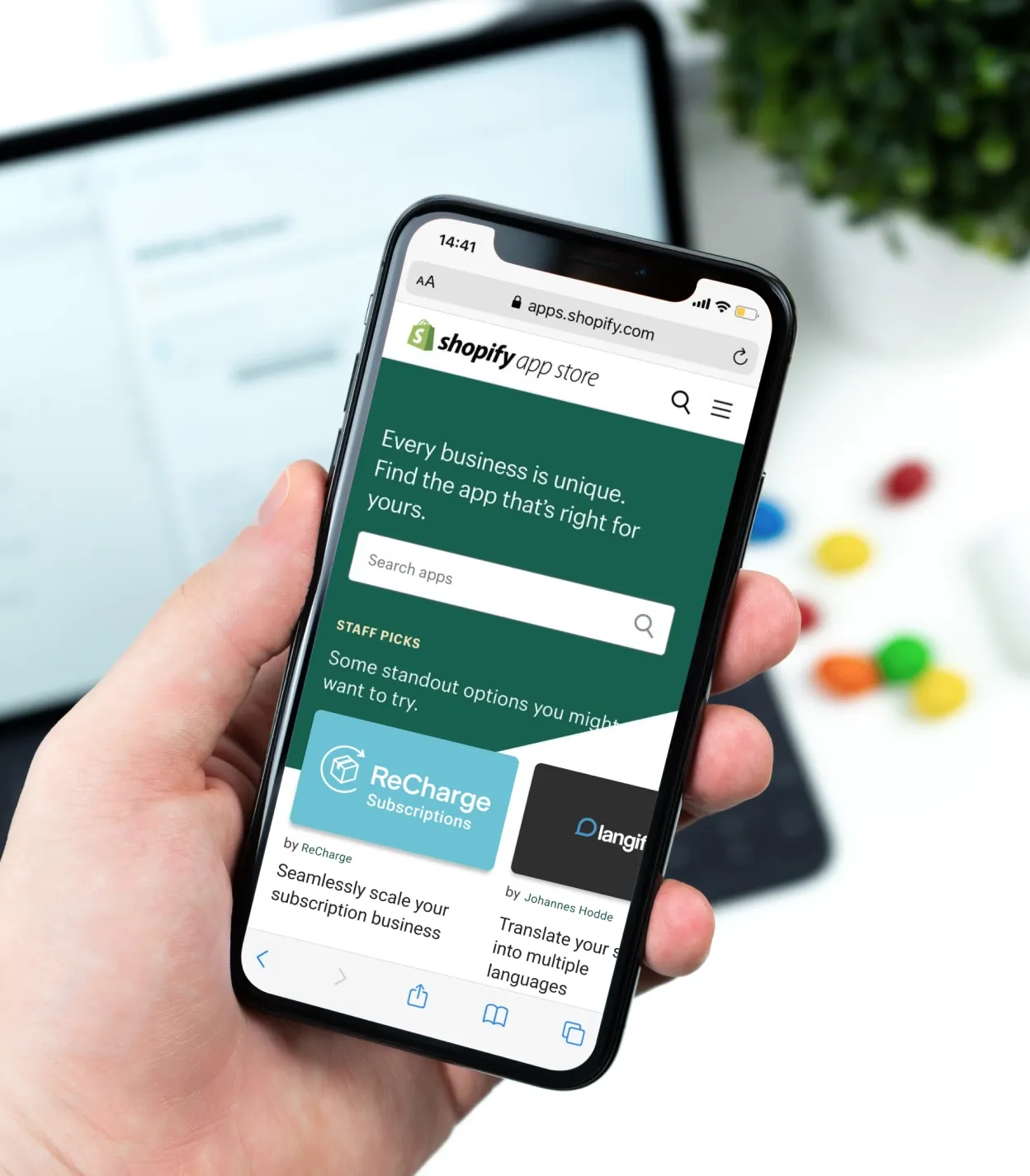
Once you start your e-commerce venture, going with a traditional Shopify store is an affordable way to get things going. Pre-built templates save you time and money you’d otherwise spend on development, and you have all the features you need at this stage.
As your business grows, you find yourself constricted by Shopify’s frontend capabilities. Loading speed isn’t as fast as it used to be. You realize you’re limited in customizing your URLs. You can’t integrate all the third-party tools. You need to manage multiple codebases.
Luckily, you don’t have to rebuild from scratch to resolve all those issues. Instead, you can separate your frontends (i.e., storefronts) from the backend (i.e., product, order, and customer databases) and switch to using Shopify only in the backend.
If you’re wondering if this approach is right for you, you’ve landed on the right page. As a headless Shopify development company, we at DigitalSuits know the Shopify headless architecture inside and out. We’ve implemented it for multiple brands, from OURA to Namza.
Today, we’ll share our expertise with you in this Shopify headless commerce guide. Read on to find out what a headless Shopify store is, the pros and cons of the Shopify headless architecture, and how to implement it.
What is a headless Shopify store?
First, let’s answer one question: What is headless Shopify? In a nutshell, headless architecture means separating your frontends (e.g., website, mobile app, wearable app) from the backend (product, order, and customer databases). The two interact via APIs.
In traditional monolithic architecture, the frontend and the backend are tightly coupled, so you can’t independently change the former without touching the latter. This creates several problems:
- Introducing changes to frontend is time-consuming and expensive.
- You’re limited in the scope of changes you can make.
- You can’t easily scale individual components.
- Changing a framework or language is complicated or next to impossible.
Headless architecture removes these constraints. As a result, you can introduce any changes you want to the frontend faster. According to Salesforce 2022 research, 77% of companies using headless architecture claim it gives them more agility, particularly allowing them to change their digital storefront swiftly.
Now, let’s answer a different question. What is Shopify headless like in practice? In a nutshell, you won’t be able to use the Shopify themes or theme editor anymore. Instead, you’ll have to create a storefront from scratch or use Frontend-as-a-Service tools.
For content management, you can use Shopify as headless CMS or a third-party one (e.g., Contentful). Shopify will continue to power database management.
Eight pros of going headless with Shopify
Don’t know if you should go headless? Let’s review the eight advantages of switching to the Shopiy headless architecture to help you decide.
Unlimited flexibility and customization
This is the main advantage of headless commerce: unlimited flexibility in every aspect of your store, from design to features and integrations. The theme editor or available Shopify apps no longer constrain you. You can use any tech stack for building the storefront and add any features to it, provided they’re possible to implement with the technologies you’ve chosen.
Unlimited flexibility and customization mean that you can finally make your store stand out among your competitors. The headless architecture lets you create truly unique customer experiences with best-in-class technology.
No vendor lock-in
Speaking of the best-in-class approach to your digital ecosystem. With the Shopify headless architecture, you are free to use any technology for creating a storefront. Moreover, choose any content management system, CRM, or ERP solution to go with your headless Shopify store.
This allows you to opt for the best solution for your needs across the board, including developing and integrating a custom one. The best-in-class strategy has a ripple effect on your efficiency, cost optimization, customer experience, and productivity.
Improved scalability
If your store doesn’t handle organic spikes in traffic well, it’s a scalability issue – one that going headless can address. Switching to the Shopify headless architecture will enable your store to show solid performance even during sales.
Headless architecture also allows you to scale your business faster, too. Thanks to a reduced time to market for new features and integrations, you can automate or enhance specific processes faster. For example, you can introduce personalization at scale with the tool of your choice.
Better performance and speed
Even a 0.1s increase in speed increases conversion rates by 8% for retail websites, as Deloitte found in its study. Plus, Google considers loading time a ranking factor, so it’s essential for SEO. That’s why continuously optimizing your storefront for speed isn’t optional: it’s a must-do if you want to see a rise in conversion rates.
Monolithic applications typically experience speed issues as more and more third-party integrations are added to the backend. But since headless architecture means decoupling the frontend from the backend, those integrations no longer impact loading time on the client side, speeding up your storefronts.
Faster time-to-market
Your storefronts are separated from the databases in headless Shopify, meaning you don’t need to touch the backend to tweak the frontend. So, you can deploy new features faster, allowing you to innovate and stay ahead of the competition.
That said, keep in mind that you’ll need to hire Shopify headless developers to introduce those changes, as they require technical expertise. You may turn to a development partner or hire an in-house team.
Unified omnichannel customer experiences
With the headless approach, you can add as many storefronts as possible. Plus, you’re not limited by supported types of storefronts, allowing you to increase the number of touchpoints with your customers. For example, with headless architecture, you can easily launch applications for wearables.
But it’s not just about expanding the channel variety. A single backend that communicates with all frontends empowers seamless omnichannel customer experiences, like recovering a cart on another device. Headless architecture also facilitates collecting customer data from all touchpoints and organizing it in single customer views, thus powering highly personalized UX.
Streamlined multi-region e-commerce
If you have several websites for different locations or in different languages, monolithic Shopify architecture requires you to manage separate codebases and use different URLs for each of them. This requires you to spend more resources on managing and updating each codebase.
The Shopify headless architecture, in turn, allows you to use one codebase for every regional storefront. So, if you want to integrate them with a new CRM, for example, you have to do it only once. Tweaking products or adding discounts can also be done once for all storefronts.
Full URL customization
In monolithic Shopify stores, any multi-level URL will get automatically flattened. For instance, if the page is located in /furniture/bedroom/beds, it’ll get automatically changed to furniture-bedroom-beds. On top of this, certain pages follow a predefined structure that you can’t customize. For example, collection pages have to be located at /collection/.
All of the above can undermine your SEO efforts. Luckily, going headless allows you to take full control of the URLs so that you can optimize them for search engine queries how you see fit. This translates into better rankings and, therefore, increased organic traffic.
Four cons of going headless with Shopify
Of course, switching to Shopify headless architecture has its caveats. So, is Shopify headless commerce right for you?
Here are the four headless Shopify problems and challenges of this approach that you should be ready for before making a decision:
- Considerable upfront investment. You’ll need developers to build the storefronts from scratch, connecting them with the backend, and implementing third-party integrations. All of this comes with significant upfront costs.
- Tricky third-party app integration. It involves working with Shopify headless API, meaning you’ll probably need to hire dedicated Shopify developers to execute it. Some of the apps you’re using now may not be able to communicate with Shopify’s Storefront API at all.
- Complex migration to headless architecture. You or your development partner will have to consider virtually every aspect of your e-commerce business to customize the new ecosystem correctly. It is a time-consuming endeavor, especially if you’re used to plug-and-play systems and apps.
- More dependence on developers. Introducing storefront UI/UX changes or integrating a new third-party solution requires development skills. Plus, someone will have to maintain and update your systems continuously. This makes for a years-long commitment to hiring in-house or dedicated developers.
Considering these challenges, smaller e-commerce businesses will find that the cons outweigh the pros. Going headless is also not a viable option if you can’t afford to hire an in-house development team or an external development partner.
Plus, going headless isn’t worth it if your current website or app is simple and doesn’t require more than what Shopify can offer you as a traditional CMS.
How to implement Shopify headless architecture: your toolkit
If the pros outweigh the cons in your case, we have prepared a beginner’s headless Shopify tutorial for you. Here are the three tools you can expect to find in your toolkit:
- Storefront API. This is a GraphQL API that powers communication between the Shopify backend and storefronts or third-party apps. Third-party integrations will require developing GraphQL APIs that communicate with Storefront API.
- Shopify Hydrogen. Hydrogen is a React-based framework for building headless storefronts. It eliminates the need to use Shopify Liquid, a unique coding language. Instead, developers can use JavaScript and React, the most popular technologies.
- Shopify Oxygen. Oxygen is a hosting platform for headless storefronts built with Hydrogen. It allows you to deploy and manage headless stores without dealing with server infrastructure yourself.
While avoiding Storefront API isn’t an option, you’re free to opt for or abstain from Hydrogen and, therefore, Oxygen. Instead, you can use other frameworks and programming languages for frontend development or opt for Frontend-as-a-Service. You can read up on this stack’s pros and cons in our blog post on using Hydrogen and Oxygen in headless commerce development.
N.B. You’ll need to switch to Shopify Plus if you currently use a different plan. Headless architecture is available as an option only to Shopify Plus subscribers.
Takeaway
Shopify headless architecture, while having considerable advantages, isn’t for everyone. It requires you to invest in building the storefronts and adding the necessary integrations. It implies running maintenance and upgrading costs. And it makes you reliant on developers and their expertise.
That’s why going headless is best for large e-commerce businesses ready for these challenges. It’s also a must-consider if you’re running a multi-storefront operation and operating in different locations. Only then will you be able to capitalize on the benefits of going headless to the fullest.
Planning to go headless with Shopify or hire dedicated Shopify developers? We’d be happy to lend your expertise in Shopify headless services and create a system that sets your business up for success. Contact us to discuss how we can be of service to you.













Was this helpful?
0
No comments yet